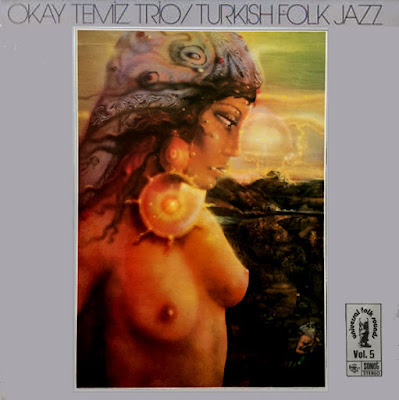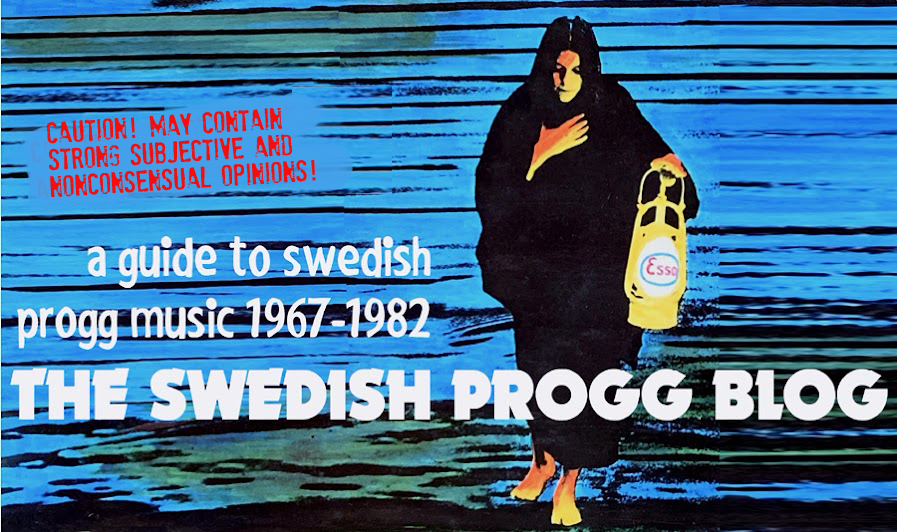Okay Temiz's albums are sprinkled all
over this blog, but this post fills in
the gaps in his discography up to 1982. It's a rather voluminous body
of work, and if you count the albums with him only as a sideman, it
becomes unfathomable. But
I always take a closer look on an album with his name on it. His name
is a stamp of approval. If he's there, it can't be all that bad.
 OKAY TEMIZ TRIO – Turkish Folk Jazz
OKAY TEMIZ TRIO – Turkish Folk Jazz
(Sonet, 1975)
Instrumental
International relevance: ***
What
could possibly go wrong with a title like that? Nothing, and nothing
does either. It's recorded as a trio with Swedish jazz legend Björn
Alke on bass and Temiz's fellow countryman Saffet Gündeger on
clarinet (plus multiple arrangements signed Maffy Falay although he
doesn't appear on the album in person). Temiz's Turkish roots have an even
stronger emphasis here than on several of his other albums, and the
melodies and harmonies get to fly high and free within the smaller
trio format. It also means there's more room for Temiz's drumming,
and he's really going for it here. He plays in all directions at
once, wide and deep, high and low, and right at you. Truly musical drumming, and
Gündeger finds his way around the drummer's thunderous tumble. He
blows his instrument so hard as if his life depended on it, making
wild runs like the clarinet's Coltrane. Even Björn Alke, anything
but a bass bungler, gets overshadowed by the Turkish typhoon of
sound. It's as if he knows he better stay out of the way and keep
the pulse going elaborately but without trying to show off. A one
hundred percent stunning album.

ORIENTAL WIND – Zikir (Sun,
1979)
Instrumental
International relevance: ***
The release history of ”Zikir” is a
bit complicated and I'm not going to get all tangled up in trying to
explain which release is which and what songs are on which edition, as the CD reissue
on Ada Müzik sets everything straight in terms of songs included. The picture above shows
the album cover used for most early European releases.
This is a very different beast to ”Turkish Folk Jazz”.
With more musicians involved, the arrangements are more rigid. There
are still room for improvisation of course, but there's nothing here
that can match the fury of ”Turkish Folk Jazz”. There's also
something about the sound that breathes jazz fusion air, a sort of
smoothness that I think is too much out of place for this music. I
can just imagine what a smaller band and a more sympathetic
production would have done to the outcome. Still there are
entertaining moments, such as the wacky ”Kabak Tatlısı” which
sounds as if they played a jew's harp through a wah-wah and then
added drunken ducks on top of it. But as a whole, ”Zikir” stands
as one of the weaker Temiz efforts.

ORIENTAL WIND – Live In Bremen (JARO,
1982)
Instrumental
International relevance: ***
This 1981 recording from the Packhaus
Theater in Bremen opens with ”Batum”, a throwback to Temiz's Sevda
days although Lelle Kullgrens electric guitar gives it a very
different vibe. I don't like his playing at all. But to be honest, I don't think Oriental Wind
had a good evening back then in late October 1981. The music sounds
strained (very unusual for a Temiz album!) and tense in a bad way.
It's almost as if there was something worrying them, as is they had
something else on their mind and tried to make up for the missing
spark with force. Some moments here are better than others, but I
miss the natural flow and telepathy between the musicians most of the
time. And flow and telepathy are crucial for this music to work.

OKAY TEMIZ'S ORIENTAL WIND – Live At
Montreux Jazz Festival 1982 (Caz Plak, 2022)
Instrumental
International relevance: ***
Ah, now we're talking! Forty minutes of
top range Turk jazz action! Still guitar in the mix, but Lelle
Kullgren is out and Stefan Osterberg is in and he's much more
responsive to the moment, firing off some almost Terje Rypdal-like
salvos that hit exactly where they should, But everybody's on the
same page here, effortlessly striving in the same direction, thinking
with one unified mind. This Montreux show, left in the vaults for a
baffling forty years, is the exact opposite of the stifled Bremen
date. It's all
about the collective efforts, but every musician needs to be
mentioned by name as they all play on their absolut top. Lennart
Åberg moves like a panther in his death defying guerilla sax solos.
Palle Danielsson is freaking insane on the bass, playing stuff that I thought was humanly impossible. He's almost like an orchestra in
itself! Bobo Stenson's piano and keyboards might seem a bit tame in
comparison, but although he fires away some dazzling keyboard runs,
his main role is being the glue that keeps it all together, filling out whatever musical spaces need to be filled The ensemble play
is out of this world, it's more than telepathy – they're tight as
siamese quintuplets. No need to hold it back: Of every album I've written
about here – and we're talking thousands of albums –
this album is among the very, very, very best.
Turkish Folk Jazz full album
Zikir full album playlist (CD version)
Live In Bremen full album playlist
Live At Montreux full album playlist (Bandcamp)







































